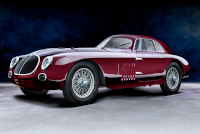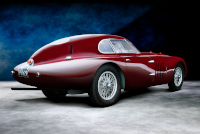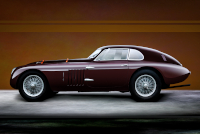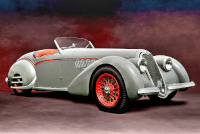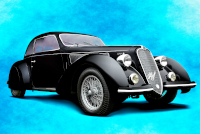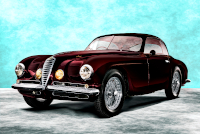Location:
St. Michaels Concours d'Elegance, 2008
Owner: Mark Gessler | Potomac, Maryland
Prologue:
Note that #915080 has twice changed hands since photography, once in 2010 and again in 2023.
Even if purists disagree with the fabrication, the involvement of Carlo Felice Bianchi Anderloni in #915080's development is quite valuable. I can agree that other reproductions of the Touring Berlinetta Aerodynamica are more authentic to the original as seen in period photographs. That much is certain. But it's worth pointing out that the modern Peter Brock Coupe is not meant to be a replica of the original Shelby Daytona Coupe. Not to presume more than I know, but when engaging a designer in a design project, it might be naive to expect that he supresses all instinct to create merely in deference to one's desire to re-create.
Those involved at the time believe that this reproduction coachwork on chassis #915080 is the last project Carlo Felice Bianchi Anderloni worked on prior to his death. If that is the case, would we rather malign the product for not being what it was instead of considering what it is?
- - - - - - - - - -
► Image Source: Nikon D200 (10.2 MP)
References:
- ItaliaSpeed: Perhaps the most detailed and complimentary description of chassis #915080.
- Gooding & Company: The auction listing for the car's 2010 sale.
- Sports Car Market: An interesting editorial analysis of the car's value as a re-creation.
- UltimateCarPage: Our trusty source provides Tipo 256 specifications through a similar aerodinamica example from Europe, by Wouter Melissen, (pre-December 2004).
Much work involved to suss out what's going on here... The last classic era Mille Miglia occurred in 1940, having skipped the previous year. Sporting regulations eliminated the dominant, eight-cylinder Alfas, opening the door for small-capacity sports cars, causing Alfa Romeo to get creative with the new 6C 2500. Alfa developed the Tipo 256, a series of perhaps 20 sports-racing cars built on shortened 2,700 mm chassis, of which little more than 30 may have been available. One of these cars used aerodynamic berlinetta coachwork built by Touring. The concept and execution followed the same philosophy as the winning BMW 328. For Alfa Romeo, Count Carlo Felice Trossi and Ascanio Lucchi piloted the Berlinetta Aerodinamica in the Mille Miglia, finishing eighth. Ahead of them placed three 6C 2500 Touring Spiders and three BMW 328 Spiders, as well as the winning 328 Touring Berlinetta. The car, like so many that year, was never seen after.
Also note that Prince Birra and Raymond Sommer shared the Berlinetta Aerodinamica prior to the Mille Miglia at the 1939 24 Hours of Le Mans, though the car did not finish.
Carlo Felice Bianchi Anderloni and the Reborn Berlinetta Aerodinamica
The car profiled here, #915080, is an original 2,700 mm Tipo 256 chassis. The car emerged either in the late 1980s or early 1990s, (citing dates of 1989 or 1993, depending on the source), in Eastern Europe, (perhaps the Czech Republic), wearing locally sourced cabriolet coachwork but retaining an original 6C 2500 motor that remains with the car today. In 1994, the Italian owner enlisted the help of Dino Cognolato of Carrozzeria Nova Rinascente (or "New Renaissance") in Vigoza, Italy, who first discovered and verified the car's Tipo 256 history by using X-ray imaging of the chassis and authenticating its number stamping. The firm set about restoring the chassis. At some stage they or the owner decided to rebuild the Berlinetta Aerodinamica. They then contacted Carlo Felice Bianchi Anderloni, same of Carrozzeria Touring Superleggera, who worked with the 6C 2500 upon joining Touring in the 1940s, and who provided access to Touring's records.
At least three enthusiasts have built noteworthy re-creations of the Berlinetta Aerodinamica. Anderloni's involvement in #915080's all-Italian transformation could have arguably provided a certain first-person quality control narrative, though it seems the re-creation on chassis #913191 looks closer to the photographs of the original car, which wore number 76 in the Mille Miglia. That much is still guesswork. But to speculate further, it might be possible that #915080 is as close to what the original could have been—as designed—rather than how it emerged in the early hours of global conflict.
Speculation in this case would mean that Anderloni took the opportunity to implement the style he wanted, but could not achieve in period. We have seen a similar scenario with the re-creation Superformance Daytona Coupe, which, though never intended to be a perfect replica of the original Shelby, includes features Peter Brock wanted for the original, but for time and resources could not achieve.
This is to say that working with an automobile's original designer opens a project to reinterpretations bred from the creative mind. Perhaps it is not fair to expect a creative individual to rest on a 55-year-old achievement, as would be the case with the Berlinetta Aerodinamica, rather than seize the moment to invent. This car, #915080, turned out to be the last project of Anderloni's life, and from that perspective it is significant in its own right. Whether the car could more closely resemble photographic evidence from the 1940 Mille Miglia is a matter others have proved possible anyhow.
Persistent Mystery of the 1940 Alfa Romeo Le Mans Aero Body
The original Berlinetta Aerodinamica chassis number remains obscure. My own checking pointed toward chassis #915077, but I then found a comment on the subject from the car's owner of record dated over twelve years ago. Mark Gessler wrote, "I have researched the Milan registration number which matches to 915007 an 'open car.' I am not aware of any credible evidence of a match between a specific serial number and the 1939 Le Mans body." That comment underlines the Tipo 256 reality. Among a handful of original chassis, it is likely that none of the original coachwork remains. The war destroyed Alfa Romeo's production records, and the Tipo 256 was simply too close to the conflict to survive intact.
Motor: Tipo 256, 2,443 cc inline straight 6-cylinder, cast iron block, light-alloy hemi-head | 72 mm x 100 mm | 8.0:1 compression
Valvetrain: DOHC, 2 valves per cylinder
Aspiration: triple Weber 36 DO2 carburetors
Power: 125 bhp at 4,900 rpm
Drivetrain: 4-speed gearbox, rear-wheel drive
Front Suspension: twin trailing arms, coil springs and hydraulic shock absorbers
Rear Suspension: swing arms, radius arms, longitudinal torsion bars, friction dampers and tubular shock absorbers
Architecture: steel ladder frame with aluminum Superleggera coachwork by Touring of Milan
Kerb Weight: 1,160 kg (2,557.36 lbs)
Wheelbase: 2,700 mm (106.3 inches)
Top Speed: 197 km/h (122 mph)
Etymology:
'6C 2500' refers to the inline six-cylinder block of nearly 2.5 litres displacement. 'SS' denotes the Super Sport version, which applied to the body of 6C 2500 production cars, (and is not a reflection of the car's true Tipo 256 history). The name 'Touring Berlinetta Aerodinamica' refers to the coachwork designed by Carrozzeria Touring Superleggera of Milan. A berlinetta is a small closed coupe, the Italian equivalent of the French berline. We add 'Aerodinamica' to recognize the car's unique aerodynamic shape.
Figures:
The difficulty in counting true Tipo 256 cars is that, as previously discussed, these cars were born too close to the war to survive intact. The war also destroyed Alfa Romeo records. Based on guesswork, about 20 Tipo 256 cars might survive, though most agree that none survived with their original coachwork. Chassis #915080 is a re-creation of a beloved, long-lost race car, though it is an original Tipo 256 chassis restored with the correct mechanical specifications.
Value:
Gooding & Company sold chassis #915080 for $748,000 at Amelia Island in 2010. More recently, the car sold at the 2023 Broad Arrow Monterey Jet Center auction for $335,000.
Ala Spessa: Integrated Streamlining in the Late Classic Era
The late classic era saw early design studies in uniform coachwork, eliminating the separate running gear concept with cohesive, wind-inspired shapes. Many Alfa Romeo cars wore aerodynamic bodies, dating back to the revolutionary Jankovitz Spider of 1935. But more than experimental designs, Alfa Romeo and Touring advanced the automotive form sequentially from the 8C 2900B Le Mans Berlinetta, to the 6C 2500 SS Berlinetta Aerodinamica, to early post-War production models that expressed the importance of a well drawn line. The Berlinetta Aerodinamica is therefore an important step in the modernization process, capable of making onlookers miss its date of inception by about 15 years.
Design Influence: Characteristics of the Original Alfa Romeo Le Mans Berlinetta
Chassis #915080 sits tall on the rear wheels, with subtle lift over the haunches and a tail that may be pronounced compared to the original Berlinetta Aerodinamica. In comparison, chassis #913191 appears to sit level at all four corners, which compares favorably with period photos of the original. Continuing the modernity theme, with its level stance and lean lines, the original berlinetta is reminiscent of a Jaguar XK-150 Fixed-Head Coupe, which would not appear until 1957. Truthfully, all Jaguar XKs exhibit strong classic era design cues, so the comparison should not be surprising, only that Jaguar wore fascia of the type seen on classic Talbot-Lago sports cars, with curves to match. In comparison, the Alfa appears simpler, if not more modern for its linearity. Having staked that claim, however, the tall Borrani wires and rudimentary trafficators place the car in the classic era.
Tank Design: Alfa Romeo Elements of the Streamlined Tank Lexicon Introduced by Bugatti
Taking a different perspective on the subject, Bugatti entered the term 'tank' into the racing lexicon with their streamlined Type 57 derivations. This term also seems appropriate for the aerodynamic Alfa. Flat flanks with a large set of louvres contain a central fuselage. The fascia appears wrapped, rather than sculpted, with barrel crests atop the front fenders and bonnet. And many of the fundamental components—headlights, grille, driving lights—hadn't yet been developed for this approach, if not this particular body, and produce a crude, off-the-shelf feeling. In this sense, 'streamlined tank' fits the simplicity of the concept, though it falls far short of the romance behind the name, Berlinetta Aerodinamica.
Aerodynamic Features: Common Highlights of the 1940 Alfa Romeo Le Mans Berlinetta
In lieu of wasting time comparing re-creations, we should rather examine the interesting features common to the best of them. The bonnet straps, for example, sit within recesses formed to the width of the leather. The windscreen is a vee design that appears at first to match the contour of the cabin, but glass technology could not accommodate curves, and so the windscreen is actually two flat panes. The fitment of the glass looks very clever, how it fools the eye. So too, the side windows make use of classic era pieces, including wind wings, which had not yet moved inboard with proper window weather sealing. And of course the door hinges appear comically large, but are also teardrop-shaped to slip the wind. So, while simple as a whole, that simplicity comes about through the smart integration of old components into a completely new body system.
Last Updated: Mar 26, 2025

